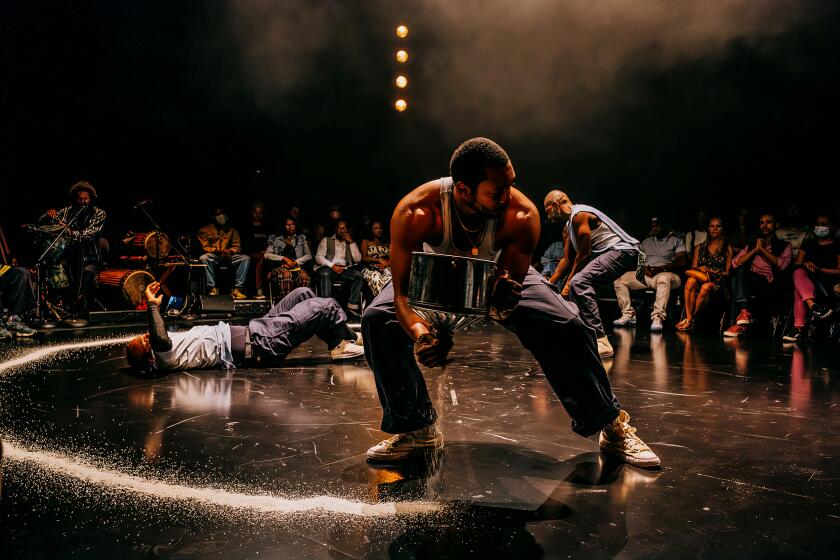‘Tis the Season to Close Shop
As the days of 2000 dwindle to a precious few, so do the theater openings. Theater closings, meanwhile, grow in number; note the 27 listed under “Closing Today” on Page 61.
Many of the major productions continue playing through the holidays--and often thrive. Chris Boneau, a spokesman for “The Lion King” at the Pantages, reported an increase in advance sales for the holidays--but that follows the usual pattern of Broadway shows and tours, he said. “Broadway does its best business during the holidays.”
Yet the majority of L.A. productions are--in box office and budgetary terms--minor productions, in sub-100-seat theaters. And most of these either close or at least suspend operations, only to reopen in January.
Why are the December holidays the dog days for most L.A. theaters? It can’t be the weather.
It’s because producers of sub-100-seat theaters don’t put on shows to make a lot of money, said Theatre LA President Lars Hansen. “So there’s no commercial incentive to keep people working.”
With the studios shutting down too, there aren’t many lucrative day jobs for actors, “so out of courtesy, [theaters] allow them to go home for the holidays.”
Broadway booms during this time of year, Hansen said, because “New York has a tradition of people coming into the city for the holidays. Here, we have localized Christmas activities”--for which people seldom travel far.
Hansen said shows that are tailored toward the holidays often do well, but few producers risk opening or even continuing other kinds of shows.
One who takes that risk is Joseph Stachura of Knightsbridge Theatre, with twin 99-seat venues in Pasadena and Silver Lake. Five Knightsbridge shows will continue through the holidays--although not on Christmas Eve or New Year’s Eve. Stachura admitted that the one holiday-themed show, “A Christmas Carol,” usually does better than the others. And he said that for shows that will continue through the holidays, he casts only actors who will commit to staying in town.
He keeps his shows going out of principle, he said: “The whole idea of Knightsbridge is to offer year-round theater, which changes every six or eight weeks. It would be so much easier to do only three shows a year. But we do it because we love doing it.”
THREE-CORNERED: Cornerstone Theater’s “For Here or to Go?” at the Mark Taper Forum marks the first time that a full-fledged local company has been invited to produce on the Taper main stage. How do other L.A. theater makers feel about the Cornerstone coup? We asked three.
“I hope it’s very successful and that with this success, the Taper will be open to hosting others,” said Tim Dang, producing artistic director of East West Players. Dang’s company has collaborated with the Taper occasionally, though never on the main stage.
The Cornerstone show “might open up new avenues of getting new audiences” for both the Taper and Cornerstone, he said. “How does the Taper develop and expand its audience in a city as divided as L.A.? This might help.”
Ron Sossi, artistic director of the Odyssey Theatre, has never seen a Cornerstone production--”I’m embarrassed to say,” he added. But from what he has heard about the group, he doesn’t see it as a rival. Referring to Cornerstone’s community collaborations, which garner relatively large grants, Sossi said, “They do a very special kind of work that none of the rest of us is doing. The pot they draw from is predisposed to give money that is social-services oriented. . . . More power to them.”
Tim Miller, the performance artist who became famous as one of the “NEA Four”--whose art was too controversial for grants from the National Endowment for the Arts--is a former neighbor of Cornerstone’s at the 18th Street Arts Complex in Santa Monica. When Cornerstone rented space there, Miller was artistic director of the complex’s Highways. Whenever he hears of another grant for Cornerstone, he said, his reaction is, “Yay! Our neighbors are hanging in there.”
But he’s not just an ex-neighbor; he’s also a huge fan, he said. “Artists in L.A. are feisty, but I’ve never heard a peep of resentment toward Cornerstone. They do what a lot of people talk about doing--engaging the community in complex ways.”
LOST IN CHICAGO: “The Lost Christmas Episode” got lost last week.
Soloist Heather Woodbury, who has performed her multi-character “The Lost Christmas Episode” at the 99-seat Evidence Room since Nov. 30, flew to Chicago to do the same show at the 500-seat Steppenwolf Theatre last Monday. But the show was snowed out.
Today, if the weather cooperates, Woodbury will return to Chicago for a rescheduled appearance at Steppenwolf on Monday. Then it’s back to the Evidence Room for another couple of weekends.
Besides the current show and other episodes of her ongoing epic “What Ever,” which will play at the Evidence Room next month in repertory with a return of the company’s “Saved,” Woodbury is using the Evidence Room as her L.A. workshop base for a new solo epic, commissioned by New York Public Theater, that will examine the move of the Dodgers from Brooklyn to Los Angeles.
More to Read
The biggest entertainment stories
Get our big stories about Hollywood, film, television, music, arts, culture and more right in your inbox as soon as they publish.
You may occasionally receive promotional content from the Los Angeles Times.






